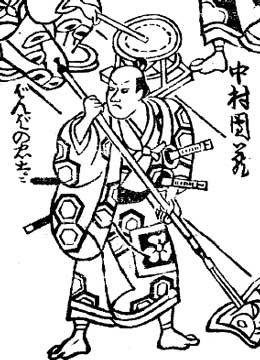| BANDď KUNIGORď |
| FOUR GENERATIONS | |||||
| Band˘ Kunigor˘ I | |||||
|
The actor Band˘ Kunigor˘ I held this name from his teens (1730s?) to Fall 1761 (?). |
|||||
 |
|||||
|
Band˘ Kunigor˘ I playing the role of Banba no Chűta in the kaomise drama "Fűryű Gosho Zakura", which was staged in the 11th lunar month of 1749 at the Naka no Shibai |
|||||
| Band˘ Kunigor˘ II Band˘ Kunigor˘ II |
|||||
|
Dates of birth and death unknown. Disciple of Nakamura Denkur˘ II, he served his apprenticeship with his master in Edo. He became katakiyaku and received the name of Nakamura Toraji in the 11th lunar month of 1763 at the Moritaza. He took the name of Nakamura Daitar˘ in the 11th lunar month of 1767 at the Ichimuraza, performing in the kaomise drama "Nue Shiged˘ Sakiwake Yűsha". He went to Ky˘to in Fall 1770 and went back to Edo in 1772. He finally took the name of Band˘ Kunigor˘ II in the 11th lunar month of 1780 at the Moritaza, performing in the kaomise drama "Tokimekiya Oedo no Hatsuyuki", which celebrated the arrival in Edo of the Kamigata star Arashi Hinasuke I. He played in the 11th lunar month of 1781 at the Ichimuraza the role of Aramaki Mimishir˘ in the kaomise drama "Mukashi Otoko Yuki no Hinagata", which celebrated the shűmei of Matsumoto Sanjűr˘ and Ichiyama Sukejűr˘. This was his last-recorded stage performance. We don't know what happened to him afterwards. He was treated as a disciple of Band˘ Jűtar˘ in the "Kabuki Jinmei Jiten", but it is quite difficult to believe it for obvious age reasons. We do personally think he was in reality a disciple of Band˘ Iwagor˘.
|
|||||
| Band˘ Kunigor˘ III | |||||
|
The actor Yamamura Tomoemon II held the name of Band˘ Kunigor˘ III from 1806 to the beginning of the 1810s (?). |
|||||
| Band˘ Kunigor˘ IV Band˘ Kunigor˘ IV |
|||||
|
Dates of birth and death unknown. He started his career in Kamigata as a disciple of the actor Yoshizawa Iroha I, who gave him the name of Yoshizawa Hachiz˘. He made his training in miyaji shibai and hama shibai. He became both katakiyaku and disciple of Band˘ Jűtar˘, who allowed him to take the name of Band˘ Kunigor˘ IV in 1812. He followed his master to Edo for two short tours, the first one from April to Summer 1812 and the second one from Winter 1817 to Fall 1817. He was active in Ky˘to or ďsaka up to 1837. He stopped acting to become t˘dori and died at the end of the Tenp˘ era.
|
|||||
|
|
| Contact | Main | Top | Updates | Actors | Plays | Playwrights | Programs | Links | FAQ | Glossary | Chronology | Illustrations | Prints | Characters | Derivatives | Theaters | Coming soon | News |